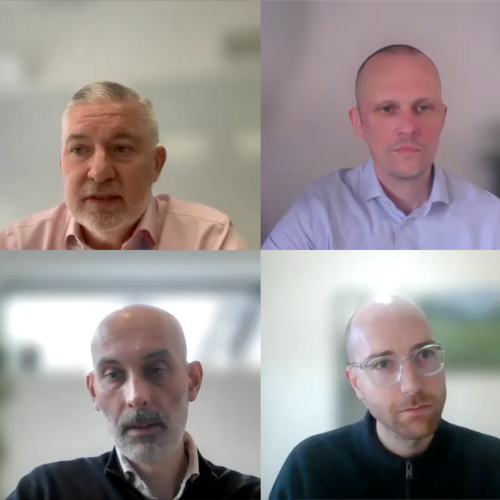- 16 Shrewsbury Road, Redhill, Surrey, RH1 6BH, United Kingdom
- Contact@betterinsurancenetwork.com

Aviva and Oliver Wyman shared details of a ground-breaking programme to start reducing carbon emissions across their claims supply chain at The Sustainable Insurance Summit in February.
In a virtual discussion hosted by Robbie Maycock (bottom right), business lead for Axa Smart Services at Axa XL, the audience learned how the two companies built from scratch a methodology to measure, manage and reduce emissions through Aviva’s claims supply chain.
Rob Bailey, Partner, Climate and Sustainability; Insurance and Asset management at Oliver Wyman (bottom left), along with Aviva’s Supply Chain Director for UK General Insurance Brian Moore (top left), revealed details of a project that broke new ground for Aviva in its Net Zero journey.
Refining the methodology
The first major step in the Aviva/Oliver Wyman collaboration was to establish a methodology for how to measure emissions associated with specific suppliers, perils and claim types across complex supply chains.
This was a challenge given that, while there are frameworks commonly used across the insurance industry for measuring underwriting emissions, there is no equivalent industry standard that could be applied to the claims supply chain.
A series of complicated questions had to be addressed in the early stages, such as where to draw the boundaries of what emissions should be considered to be within the claims supply chain and which fall outside it.
The firms also had to decide how to treat a supplier appointed by a customer or another insurer, and also how emissions should be treated when the claim involves a cash settlement.
The building blocks for reducing supply chain emissions included:
- Designing a model that could provide emissions associated with claims fulfilment that could be broken down to lines of business and type of peril, then scaled;
- Establishing baseline emissions estimates based on this initial work;
- Identifying emissions hotspots across perils, business lines and types of supplier (such as loss adjusters or vehicle repair centres), which were driving the emissions footprint;
- Oliver Wyman then helped Aviva prioritise the best opportunities for emissions reduction.
By identifying key emissions hotpots in the claims portfolio, the model enables and informs decisions for Aviva on how it should prioritise claims supply chain emission reduction efforts. For an insurer the size of Aviva which operates across so many classes of business, this factor helped the company “focus on things that move the dial the most”, Moore explained.
“It’s definitely worth figuring out early on where to where to expend your energy and focus first, because there are big sources of emissions, some of which may have straightforward solutions – don’t ignore the low hanging fruit,” Bailey added.
He pointed out, however, that emissions cannot be the sole consideration driving decisions within the strategy. “We had to think about the customer experience and ensure the cost of those emissions reductions didn’t lead to an unbearable cost for the customers.”
Engaging with suppliers
Supplier engagement is critical to the effective execution of the emissions reduction strategy. Aviva has now been engaging with suppliers for nearly two years on this topic, which Moore said has helped “take the fear away” over what is required to measure and reduce emissions – particularly among SMEs, which rely heavily on Aviva for direction.
One major achievement in this process has been that most Aviva suppliers are now signatories of the Science-Based Targets Initiative (SBTi). “I have been massively enthused by the vigour with which people have picked this up (across the supply chain),” Moore added.
The data question
When it comes to assessing third-party emissions, data quality is a perennial issue. Bailey explained that there are times when insurers will have to work with best estimates where certain data points are unavailable across the supply chain. This is to be expected when many suppliers are only at the start of their journey to understand their carbon footprint.
According to Bailey, one interim measure to resolve the data issue is to understand the process and materials used for different categories of claim settlements. In the case of Aviva, this was backed up by the use of a library of emissions intensity factors from Oliver Wyman to help produce estimates.
He added: “Over time, as the data environment improves, and the suppliers get better at providing that information, then your model improves.” The endgame, he suggested, could be to have emissions and other sustainability KPIs build into procurement dashboards.
Bailey also urged insurers to develop a standardised approach to supplier engagement so small suppliers aren’t inundated with different requirements from different insurers.
Copyright © 2023 Better Insurance Network
Follow Us


